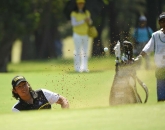
WGC-Match Play champion Matt Kuchar was celebrating his third birthday on the very day Merion last crowned a champion back in 1981. Australian David Graham, already a major champion after winning the US PGA Championship in a play-off over Ben Crenshaw two years earlier, shot a near flawless final round 67 to defeat playing partner George Burns and a fast-finishing Bill Rogers by three strokes.
The then 33-year-old Graham’s performance that day was heralded by none other than Ben Hogan as one of the greatest final rounds in history, an accolade of the highest honour coming from the man who set the benchmark in history for shot making and ball striking. Graham hit all 18 greens in regulation and found all but the first fairway off the tee in an exhibition of control as he climbed from three strokes behind Burns to win.
Hogan himself had famously won a the 1950 US Open at Merion after returning to competitive golf following the car accident that nearly claimed his life the previous year.
Graham’s win upstaged the title defence of Jack Nicklaus, who was seeking a record fifth US Open title, and Tom Watson, who was at the peak of his game, bidding for a first national championship which would ultimately arrive the following year at Pebble Beach. A decade earlier, Nicklaus had lost in a play-off to Lee Trevino at Merion which has been enshrined in golfing folklore for Trevino tossing a rubber snake from his golf bag at an amused Nicklaus as they waited to tee off on the first hole.
Nicklaus had written his own chapter into the Merion history book many years earlier when, as a 20-year-old amateur, he won the inidivdual title at the 1960 World Amateur Team Championship – the Eisenhower Trophy. Nicklaus' four-round total of 269 was 13 strokes clear of his nearest challenger. The US team won the event by a record 42 strokes.
Graham’s seven-under par total in 1981 was at the time the second lowest 72-hole score in US Open history over a Merion layout that measured a little over 6,600 yards. This was in the era of wooden clubs and balata golf balls and even then, the USGA were nervous about the length of the golf course and its capacity to protect itself from the greatest players in the world.
Pages
Click here to see the published article.











